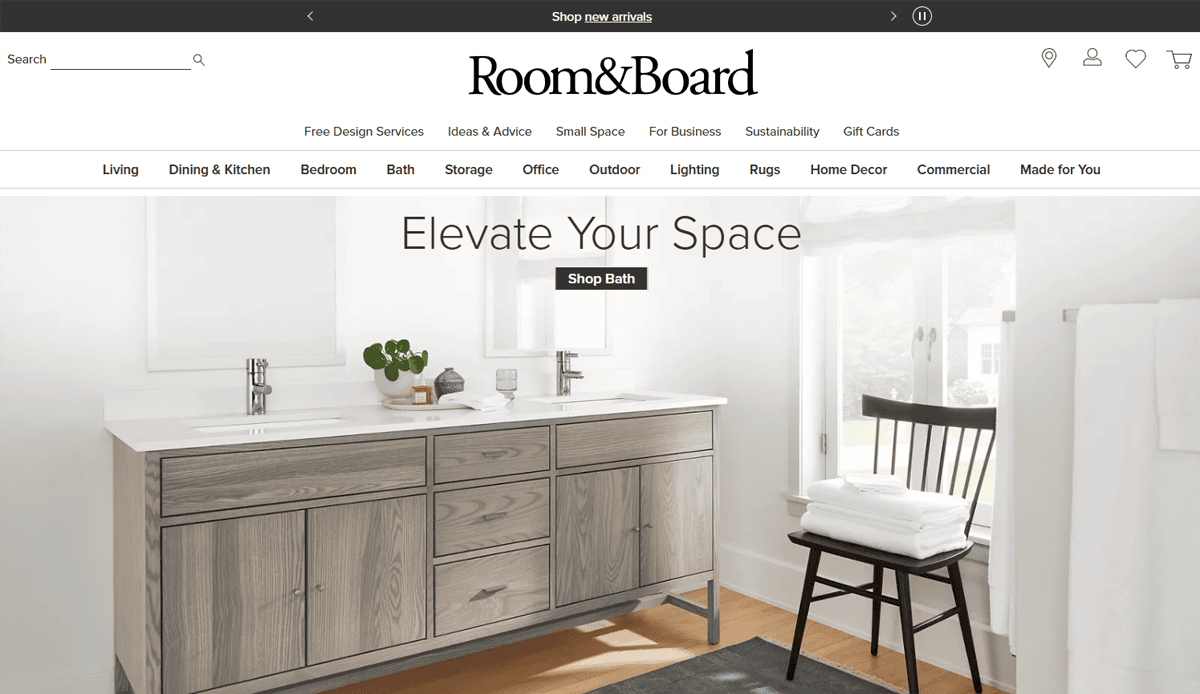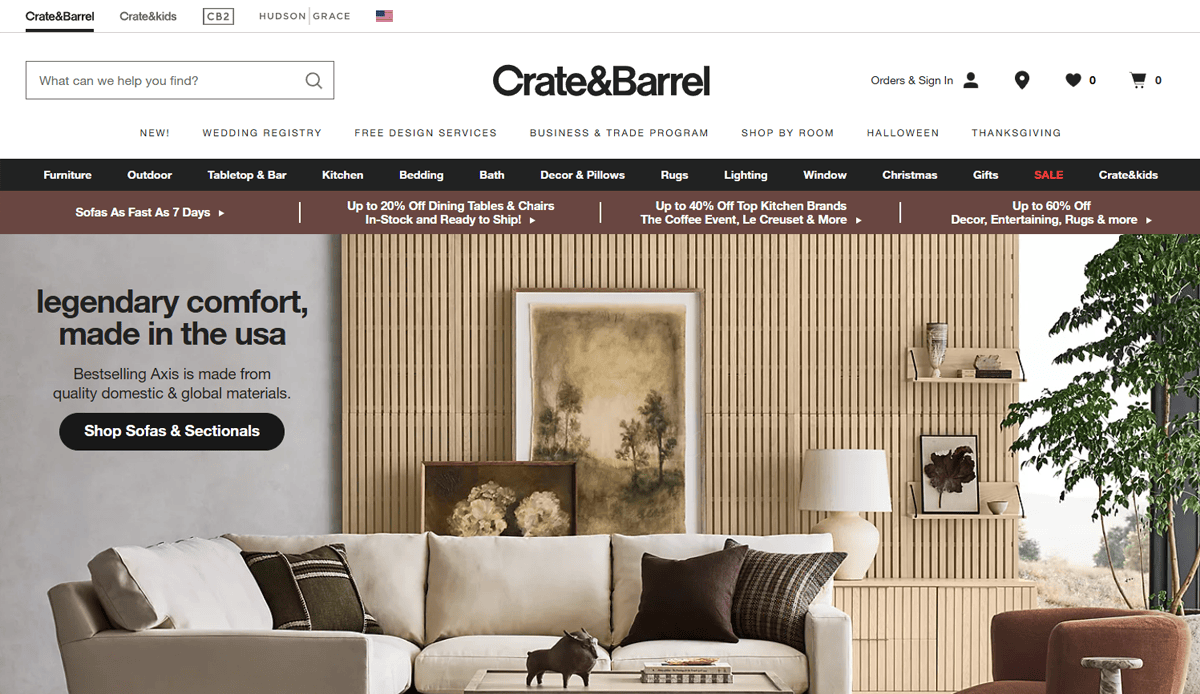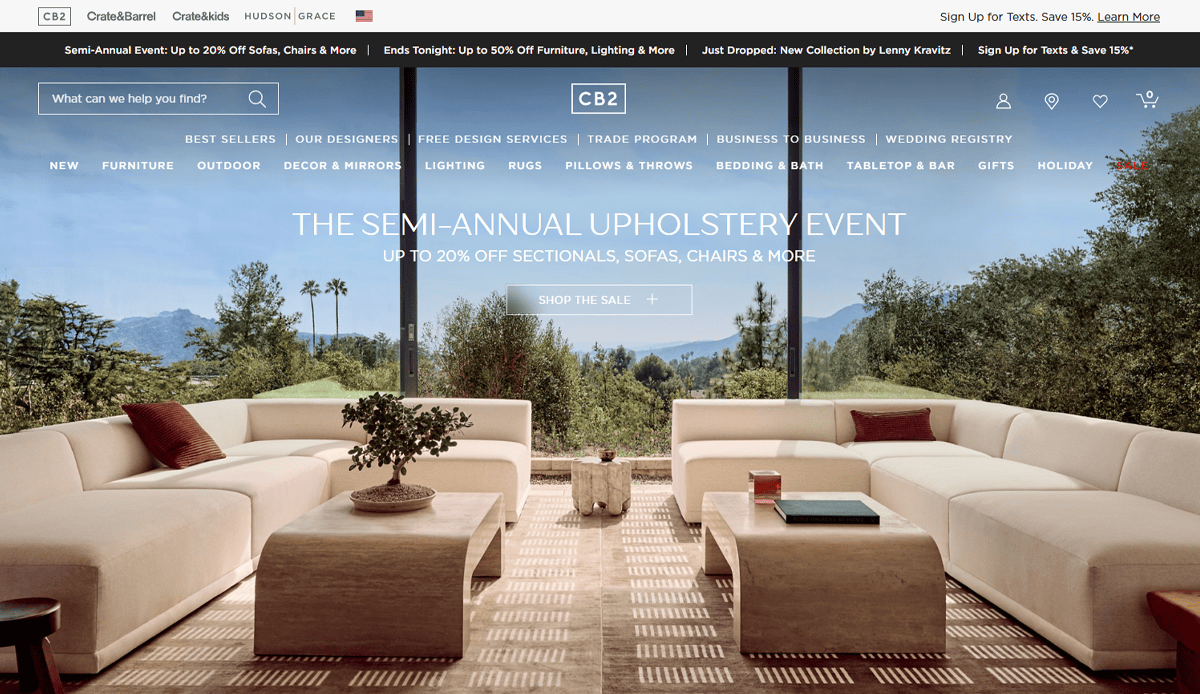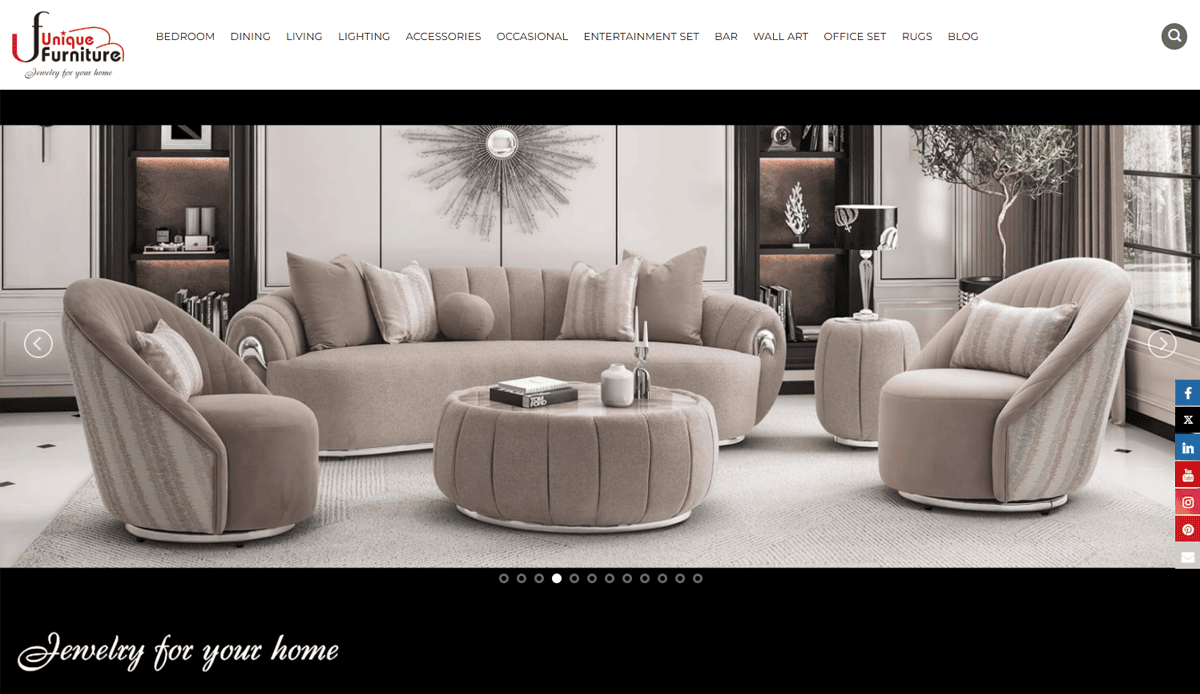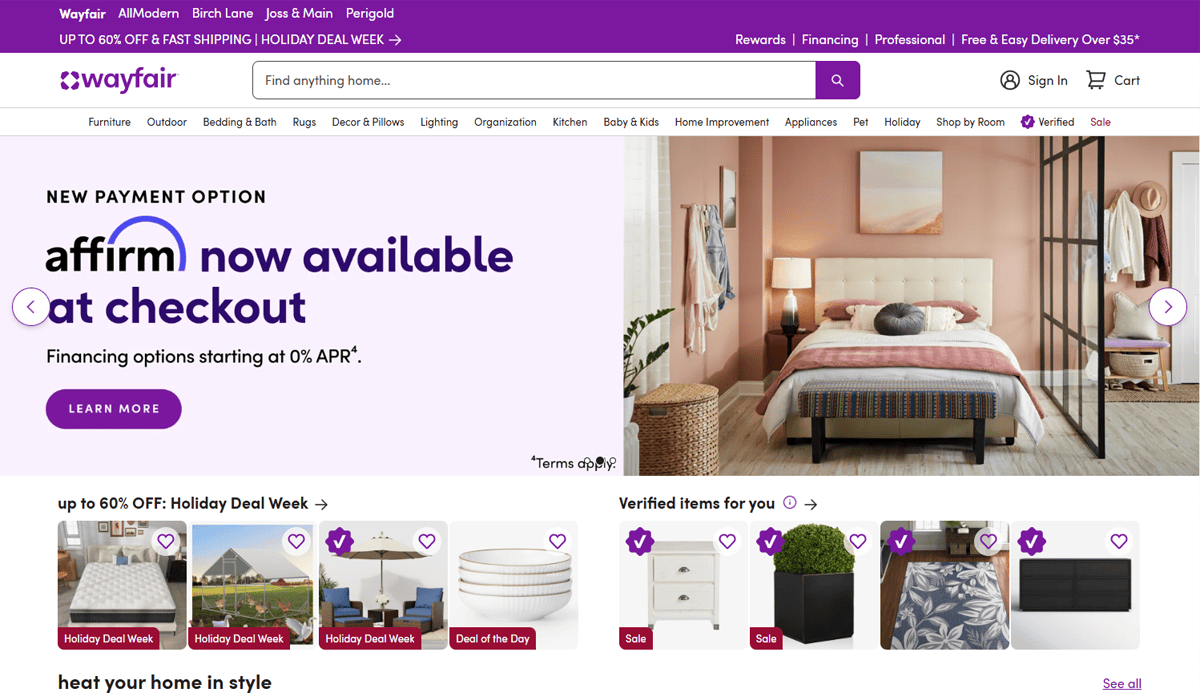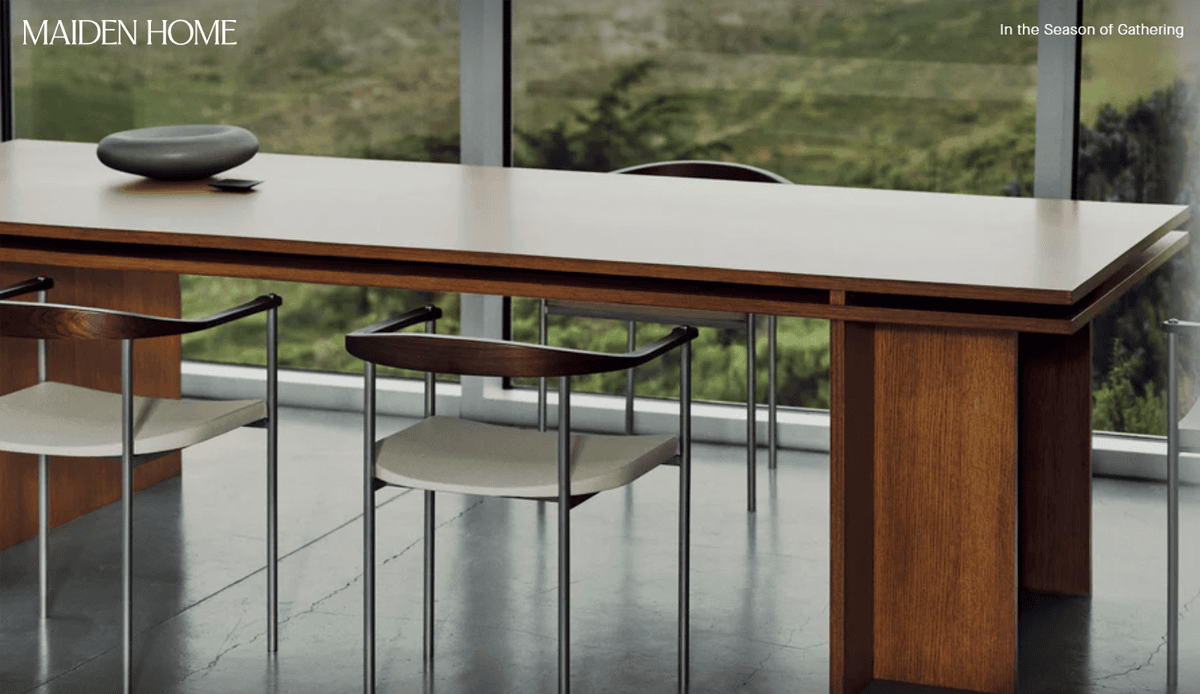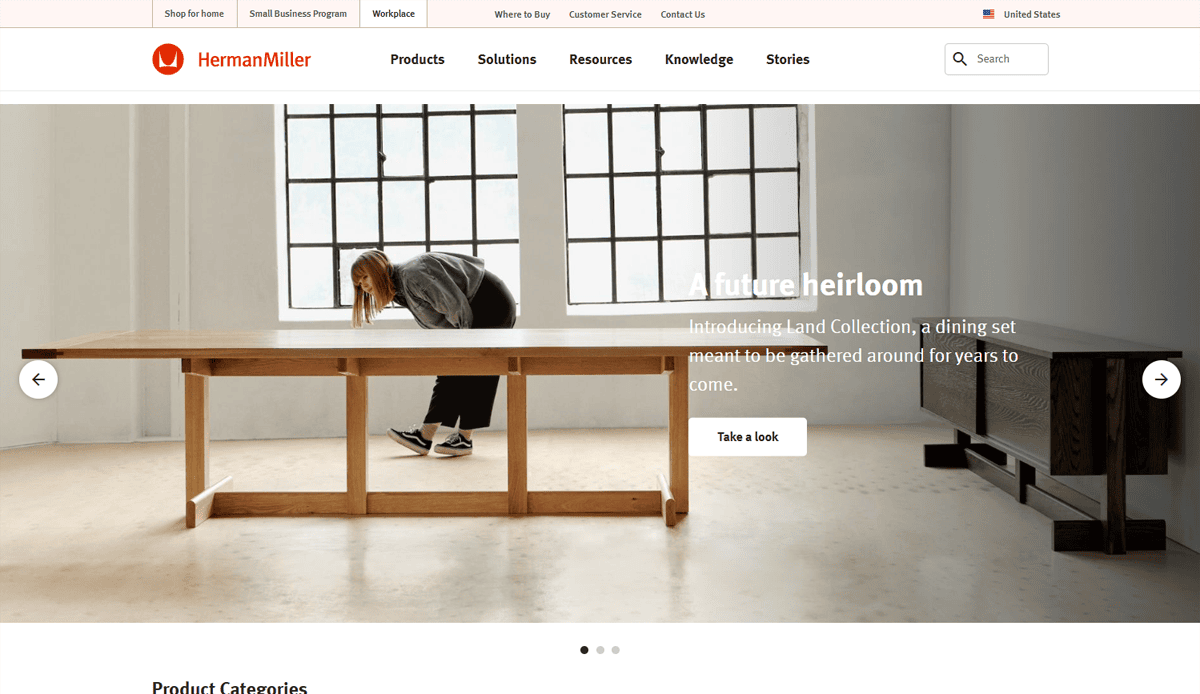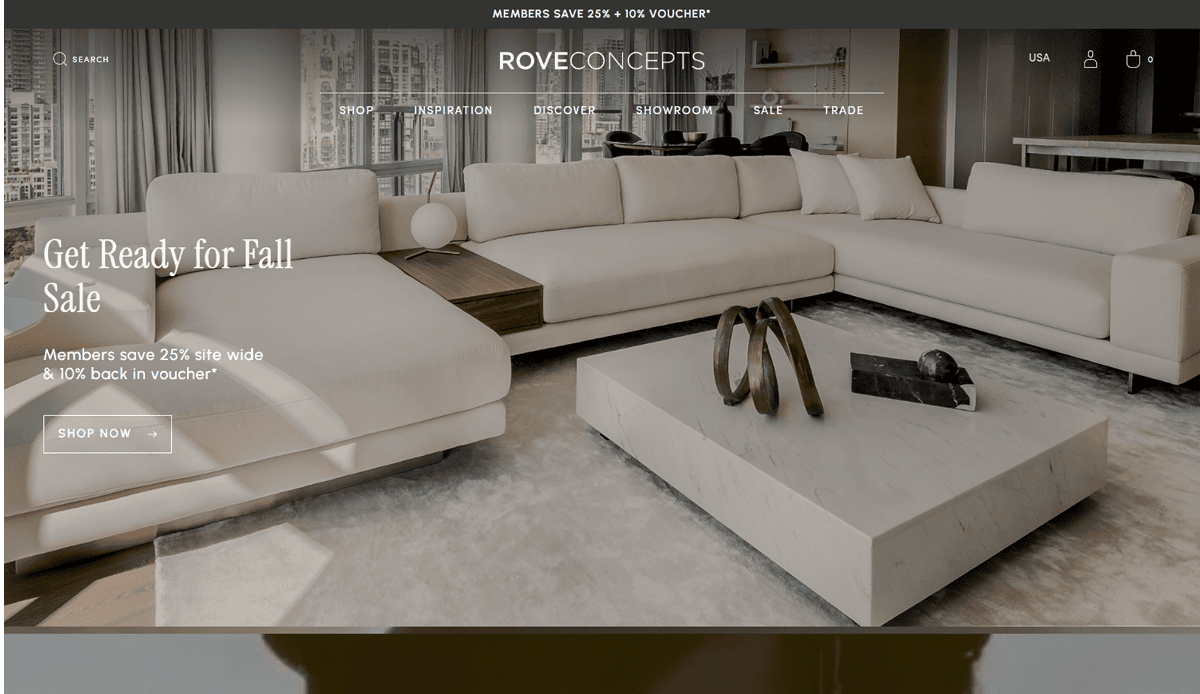Just looking for our Best Furniture Website examples list?
Key Takeaways:
- Prioritize User-Centric Design
A well-structured, intuitive website enhances user experience (UX), reducing bounce rates and increasing conversions. Implementing responsive design ensures accessibility across all devices, catering to a broader audience. HD visuals and clear navigation further contribute to a seamless user journey. - Implement Effective SEO Strategies
Optimizing for both on-page and off-page SEO is crucial for visibility. Utilize keyword-rich content, meta tags, and alt attributes for images. Building quality backlinks and ensuring a clean URL structure can significantly improve search engine rankings. Local SEO practices, such as maintaining an updated Google My Business profile, are essential for attracting nearby customers. - Embrace Emerging Design Trends
Staying updated with design trends like biophilic elements, sustainable materials, and bold color schemes can make a website more appealing. Incorporating interactive features and personalization options can enhance user engagement and satisfaction. Adapting to these trends demonstrates a brand’s commitment to innovation and customer-centricity. - Optimize for E-Commerce Success
For furniture retailers, an optimized e-commerce platform is vital. Ensure product pages are detailed with high-resolution images, clear descriptions, and customer reviews. Streamline the checkout process to minimize cart abandonment. Implementing features like augmented reality can allow customers to visualize products in their space, enhancing their buying experience. - Focus on Conversion Rate Optimization (CRO)
Regularly analyze user behavior to identify and address potential obstacles in the conversion funnel. A/B testing different elements, such as call-to-action buttons and page layouts, can provide insights into what drives conversions. Ensuring fast load times and mobile optimization are also critical factors in retaining visitors and encouraging purchases. - Maintain Consistent Branding and Messaging
A cohesive brand identity across all pages fosters trust and recognition. Consistent use of logos, color schemes, and messaging aligns with the brand’s values and appeals to the target audience. Clear and persuasive copywriting can effectively communicate the brand’s unique selling propositions and encourage customer loyalty. - Monitor and Adapt to User Feedback
Regularly collecting and analyzing customer feedback can provide valuable insights into areas of improvement. Implementing changes based on this feedback demonstrates a brand’s commitment to customer satisfaction and can lead to increased engagement and sales.
By integrating these strategies, furniture businesses can create a compelling online presence that attracts and retains customers, ultimately driving growth and success in the competitive digital marketplace.
Why Great Furniture Website Design Matters: Boost Your Business with a High-Performing Site
Today, the first impression of your business often starts online. Whether you’re a small business or a well-established brand, a sleek, user-friendly website is crucial for attracting and retaining customers. Your website is more than just a digital storefront; it’s a powerful tool that can elevate your brand, exhibit your furniture products, and transform casual browsers into loyal buyers.
With the increasing competition in the furniture industry, having an attractive yet functional website design is no longer a luxury — it’s a necessity. Potential customers don’t have time to navigate through cluttered, slow-loading websites or poorly designed templates. They expect seamless, intuitive experiences that allow them to move effortlessly and find exactly what they need. A high-performing website design plays a significant role in delivering this experience, driving conversions, and boosting your sales.
From ensuring your furniture store’s site is responsive and mobile-friendly to integrating the best design practices that reflect your brand identity, every element matters. When done right, a well-optimized website becomes a 24/7 sales engine that works for you, guiding customers smoothly from their first visit to completing their purchase, whether they are searching for a single piece of furniture or exploring your entire online store.
In this guide, we will explore how to build a successful furniture website design that looks great and performs optimally. From best practices in layout to the latest design trends and SEO strategies, we’ll dive into everything you need to know to create a site that keeps your customers engaged and coming back for more.
Website Planning & Purpose
In this industry, the website planning phase is one of the most crucial stages of the design process. It sets the foundation for a site that amplifies your pieces effectively and delivers an exceptional visitor experience. Before jumping into design or content creation, it’s important to clearly define your website’s purpose, goals, and target audience. This strategic approach ensures that your website serves your business objectives and meets your customers’ needs, ultimately driving more sales and building brand loyalty.
The first step in this planning phase is identifying the key goals of your website. Are you looking to attract local customers to your physical store, or are you aiming to build a broad online presence that sells across regions? Determining whether your site is more about showcasing your furniture collection, educating visitors about interior design, or driving direct sales through an e-commerce platform will guide the design process.
Next, understanding the target audience is essential. The furniture industry caters to a wide variety of customers, from first-time home buyers to interior designers and businesses looking to furnish offices. Your website design should reflect the preferences and expectations of your ideal customer. For instance, if your target audience includes professional interior designers, you might want to prioritize a clean, minimalist design with top-quality images of your furniture for sale, making it easy for them to look around and make quick decisions. On the other hand, if your primary audience is residential customers, incorporating user-friendly navigation with a focus on lifestyle imagery and furniture customization tools will likely resonate more.
Additionally, a key part of the planning phase involves outlining your website’s functionality. Will your site feature an online store where customers can purchase furniture directly, or will it primarily act as an informational hub to inspire potential buyers? Understanding these needs will shape the layout, including the need for product pages, shopping carts, and secure checkout processes. It’s also important to plan for key features such as product filters, search bars, and customer review sections, which improve the UX and make it easier for customers to find the perfect piece.
Another critical aspect of planning is SEO strategy. A well-designed website should be optimized from the start to improve its visibility in search engines. This includes researching and targeting relevant keywords that potential customers might use to find your digital store. Integrating these keywords throughout the site, particularly in product descriptions and blog posts, will help increase organic traffic and attract the right audience.
For more information on the core principles of web design and how they apply to building an effective furniture website, check out this guide for beginners.
By carefully planning your website’s purpose and functionality, you’ll ensure that it serves as a powerful tool to engage customers, promote your brand, and drive conversions. Proper planning ensures a smooth design and development process and helps create a website that stands out in the competitive furniture market.
Design Principles
Designing an effective website requires careful attention to several key design principles that ensure the site looks appealing and functions optimally for the user. A well-designed furniture website should create a seamless and engaging experience, making it easy for visitors to explore, learn about your products, and ultimately make a purchase. The following design principles are essential for creating a furniture website that stands out and drives business results.
- Visual Hierarchy
Visual hierarchy is a fundamental design principle that ensures important content and calls to action are easily visible and accessible to users. For a furniture website, this means using size, color, and layout to direct attention to key areas like product categories, featured items, and promotional offers. A well-structured visual hierarchy helps guide users through the site, making it easier for them to find and interact with your products. For example, using larger images or bold fonts for bestsellers or limited-time offers can encourage users to engage with those sections first. - Clean and Consistent Layout
A clean and consistent layout ensures that your website is easy to navigate and aesthetically pleasing. For a furniture website, where the products are often visually rich, it’s crucial to avoid overwhelming visitors with cluttered designs. Maintain ample white space around product images and text, which will make the content more digestible and highlight the beauty of your furniture. Consistency in the layout, such as uniform button styles, typography, and color schemes, creates a sense of professionalism and reinforces brand identity. - Mobile Responsiveness
More and more today, consumers peruse and shop on mobile devices. Ensuring that your furniture website is fully responsive—meaning it adjusts and displays perfectly across various screen sizes—is essential for reaching a wider audience. A mobile-optimized design enhances UX, reduces bounce rates, and increases the likelihood of conversions, as users can easily search and shop from their smartphones or tablets. Testing your design on multiple devices and screen resolutions is key to providing a seamless mobile experience. - High-Quality Imagery and Product Photography
The furniture industry relies heavily on quality imagery to highlight products. Furniture is a visual purchase, and potential customers want to see products from multiple angles, in different settings, and with a high level of detail. Investing in professional photography that highlights the textures, colors, and dimensions of your furniture pieces is vital for building trust with customers and encouraging them to make a purchase. Additionally, clear and high-resolution images should load quickly to avoid frustrating users. - User-Friendly Navigation
An intuitive and user-focused navigation structure is essential for guiding visitors through the experience. The primary navigation menu should be simple, with categories such as “Living Room,” “Bedroom,” “Office,” and “New Arrivals” prominently displayed. Furthermore, incorporating a search bar and product filters, such as by material, size, or price range, allows users to find the specific piece they are looking for without hassle. The goal is to ensure that customers can easily move around through the site, filter options, and locate products that match their preferences. - Fast Loading Speed
Website speed is critical to user experience and SEO. A slow-loading furniture website can lead to high bounce rates, lost sales, and lower search engine rankings. Since product pages often feature large images and detailed specifications, optimizing the site’s speed by compressing images and utilizing fast-loading web technologies is essential. Google recommends keeping page load times under three seconds to maintain a good overall experience and prevent customers from abandoning the site before making a purchase. - Effective Calls to Action (CTAs)
Clear and compelling calls to action (CTAs) are essential for guiding customers through the sales funnel. For a furniture website, this could include CTAs like “Shop Now,” “View Product,” or “Add to Cart.” These CTAs should stand out visually on the page—using contrasting colors or bold fonts—and be strategically placed in areas where users are most likely to take action, such as next to product images or after product descriptions. Well-designed CTAs will drive conversions by encouraging visitors to engage and make purchases. - Brand Consistency and Storytelling
Brand consistency plays a major role in creating a strong identity for your furniture business. From color schemes to typography, every element of your website design should reflect your brand’s values, voice, and overall aesthetic. For example, if your digital storefront focuses on sustainability, your website design should incorporate natural tones and highlight your eco-friendly practices through storytelling and visuals. A consistent and authentic narrative throughout the site can help build trust and foster an emotional connection with visitors. - Seamless E-Commerce Functionality
For companies with an online store, e-commerce functionality is a core aspect of the website design. A seamless shopping experience includes easy product selection, a smooth checkout process, and multiple payment options. It’s essential to ensure that the cart is always visible and easily accessible, that shipping and return policies are clearly outlined, and that security features are in place to protect customer data. Additionally, integrating product reviews and ratings can further enhance the experience, allowing customers to make informed decisions. - SEO-Friendly Design
An SEO-friendly website is designed to help your content rank well in search engines, which can drive organic traffic to your online store. This involves structuring your content with proper header tags (H1, H2, etc.), optimizing images with alt text, and ensuring clean, keyword-rich URLs. The content on your product pages should include detailed descriptions of each furniture piece, focusing on important keywords related to your products, such as “modern sectional sofa” or “reclaimed wood dining table.” By following SEO best practices, your site will look great and attract the right audience.
For a deeper dive into the entire web design process and how it applies to creating a successful website, check out this step-by-step guide to the web design process.
By implementing these key design principles, you can create a furniture website that is visually stunning, user-focused, and optimized for conversions. A well-designed website will highlight your inventory in the best possible light and enhance the overall customer experience, ultimately driving more sales and growing your business.
Content & Navigation
When designing a website for a furniture company, the structure of your content and navigation is paramount to ensuring that visitors can easily search, engage, and make a purchase. A well-organized and intuitive website layout is key to creating a smooth visitor experience, which is essential for encouraging sales and building brand loyalty.
The first step in structuring content for a website is to establish a clear and logical navigation system. A simple yet effective approach is to organize content based on categories that align with how your customers would naturally search. For example, main navigation items could include “Living Room Furniture,” “Bedroom Furniture,” “Office Furniture,” “Dining Room,” and “Outdoor Furniture.” This makes it easy for visitors to quickly find what they’re looking for and ensures that the website layout remains uncluttered and efficient. Each category should then break down into subcategories for easier navigation, such as specific types of furniture like “Sofas,” “Chairs,” “Tables,” or “Storage.”
For e-commerce websites, it’s also important to incorporate key design elements that make browsing an effortless process. Filters for sorting products by price, size, color, material, and style are essential for helping customers find exactly what they need. Additionally, integrating a search bar at the top of the page allows users to quickly search for specific items, whether they are looking for custom furniture or luxury furniture. For example, a luxury furniture website might include a prominent search bar and filters that focus on high-end materials and designs to match the luxury brand’s image.
Each page should be designed with purpose in mind, ensuring that the furniture gallery features products in an organized, appealing manner. Top-quality images are crucial in the furniture industry, where the furniture design and craftsmanship of each piece are important to the customer’s purchasing decision. You should also ensure that each product page includes detailed descriptions, including dimensions, materials, and design features, along with multiple images that allow visitors to see the furniture online from different angles. For websites focused on ecommerce website development, it’s essential to have a clear and concise call-to-action (CTA), such as “Add to Cart” or “Buy Now,” which prompts users to complete their purchase easily.
The website navigation should also cater to different types of visitors, such as those who want to shop right away or those who need inspiration before making a decision. To achieve this, creating separate sections for furniture design inspiration or furniture website design examples is useful. These sections can include curated collections or furniture photography that highlights specific themes, like modern furniture or minimalistic design, which can attract visitors looking for inspiration. For a furniture shop that specializes in exquisite furniture, having a dedicated page that explains the craftsmanship behind each collection can build trust and increase engagement.
For visitors interested in more than just looking, it’s essential to offer a seamless experience when buying your products online. This includes ecommerce furniture websites that feature easy-to-navigate checkout processes, multiple payment options, and options for shipping and returns. The use of 3D furniture visualization tools can further enhance this experience, allowing customers to visualize how every piece of furniture will look in their space, which can be particularly important for a furniture company offering custom furniture or high-end furniture.
Incorporating design tools such as website builders or website templates that are easy to use can allow your team to update the website frequently with new products or promotions, keeping the site fresh and engaging for returning visitors. Moreover, integrating features like product recommendations based on browsing history can keep customers engaged and drive additional sales, turning a website into a tool for ongoing engagement.
To optimize your website’s layout and increase traffic to your website, ensure that the content is well-organized and designed with the user in mind. Ensuring that pages are fast to load, easy to navigate, and aesthetically pleasing will create a stunning website that attracts and retains customers. With well-structured content and navigation, your web design can showcase your products and guide your visitors effortlessly toward making a purchase.
As you design your website for your business, keeping these principles in mind will help ensure that your website stands out in a competitive market, offering a seamless experience for every visitor while boosting conversions and increasing sales.
Visual Elements
In this industry, visual elements play a crucial role in reinforcing the brand identity. A website’s visual design is the first thing visitors notice, and it sets the tone for their entire experience. Since furniture is a highly visual product, ensuring that your website design reflects your furniture brand’s values and communicates its uniqueness is essential. The right visual elements can evoke emotions, build trust, and guide users through the site seamlessly.
- High-Quality Imagery
One of the most critical visual elements on a furniture website is the quality of product images. Furniture is a tactile and visual product, and customers want to see it in detail before making a purchase. High-resolution images are essential, providing users with the ability to examine textures, colors, and design details from multiple angles. Whether you’re selling luxury furniture or custom furniture, showcasing the products with stunning visuals is paramount. Large, clear images on the homepage, product pages, and even lifestyle settings help the customer visualize how the furniture will fit into their own space. - Color Scheme
The color scheme you choose for your website has a profound impact on both the aesthetics and visitor experience. Color influences emotions and can evoke a sense of warmth, professionalism, or luxury. For example, a luxury website may incorporate rich, elegant tones such as deep blues, golds, or blacks to evoke sophistication. Conversely, a company specializing in modern furniture may opt for a minimalist design with a more neutral, monochrome palette, which aligns with current design trends. Consistency in color across all pages of the site, including headings, buttons, and backgrounds, creates a cohesive brand experience and ensures that the website feels polished and professional. - Typography
The fonts you choose also play a significant role in the overall design and usability of the website. The typography should be both aesthetically pleasing and easy to read. Too many different font styles can create a cluttered, chaotic feel, while a clean, legible typeface will make it easier for customers to read product descriptions, blog posts, or terms and conditions. Ideally, use one or two complementary font families — one for headings and another for body text — to maintain clarity and consistency. Typography also contributes to brand identity; for example, a furniture maker offering high-end furniture might opt for serif fonts that exude elegance, while a more casual brand might go for sans-serif fonts that convey modernity and simplicity. - Product Display and Layout
The layout of the product pages should highlight the furniture products in the best possible light. Utilizing minimalistic design principles is a great way to keep the focus on the products themselves, ensuring that they take center stage without distractions. For a furniture shop with a wide variety of items, it’s important to create a structured and visually clear layout. The website layout should use grid systems, so each product is displayed cleanly with ample white space around it. Providing the option to view products in a furniture gallery or offering 3D furniture visualization can give customers a better sense of scale and texture, enhancing their overall experience. - Interactive Elements
Adding interactive visual elements to the website enhances engagement and can help guide the user through their shopping journey. Interactive features such as hover effects on product images or interactive furniture design tools that allow users to customize their selections can make the website more engaging and fun. Allowing users to manipulate the design of a piece by changing its color or material can simulate a more personalized shopping experience and encourage them to spend more time on the site. Interactive product zoom features and the ability to rotate products are also key in providing a better, more informative visitor experience. - Branding and Visual Identity
Your website should reflect the personality of your brand through consistent visual styling. Visual elements should help communicate your brand story, values, and the quality of your products. For example, if your furniture company specializes in high-end furniture, your visual design should use rich, refined colors, sophisticated typography, and premium product photography to convey the luxurious nature of your offerings. The goal is to create a website that feels in line with the type of furniture design you offer, ensuring that the overall visual language resonates with the target audience. - Visual Storytelling
A website design can also benefit from visual storytelling, which helps create an emotional connection with users. Lifestyle images that show furniture online in various settings can give customers a clear idea of how a particular piece will fit into their homes or offices. Incorporating videos that show furniture being used or handcrafted also adds a personal touch and communicates the craftsmanship behind each product. These visual storytelling elements help establish the brand’s ethos and elevate the customer’s perception of the products.
Visual elements on a website are much more than just decorative; they are essential for guiding users through their journey, building trust, and creating a memorable experience that strengthens your brand. Thoughtfully chosen images, colors, typography, and interactive features ensure that the website doesn’t just showcase furniture and enhances the user’s journey, ultimately leading to higher engagement and sales. By focusing on these visual elements, you can create a stunning website that draws customers in and converts them into loyal buyers.
Ongoing WordPress Maintenance
Maintaining a WordPress website is an essential part of ensuring it remains functional, secure, and optimized for both performance and UX. Ongoing maintenance is crucial, as it keeps the site running smoothly, helps prevent potential issues, and ensures that the website continues to meet the needs of both the business and its customers.
Regular software updates are one of the most important aspects of maintaining a WordPress website. These updates include the WordPress core and plugins and themes, which often release new versions that address security vulnerabilities, improve performance, and introduce new features. For a website where product displays and user interfaces must remain smooth, these updates are crucial to ensuring that the site remains fully functional and provides a seamless shopping experience. Failure to update the WordPress core or plugins can lead to performance issues, broken features, or security vulnerabilities that can harm your site’s reputation and customer trust.
Security is another critical aspect of ongoing maintenance. A compromised website can lead to data breaches, loss of customer trust, and even financial damage. For a furniture e-commerce website, ensuring the security of customer data is paramount. Regularly checking for and fixing any security flaws, including keeping SSL certificates updated, setting up firewalls, and using security plugins, can prevent unauthorized access and hacking attempts. Furthermore, it’s important to conduct regular backups of the site’s database and files to ensure that, in the event of a technical issue, the website can be restored quickly without losing valuable content or customer information.
Performance optimization is an ongoing task that directly impacts search engine rankings. A slow-loading website can deter potential customers and negatively affect search engine rankings. Regular checks on page speed, image optimization, and caching mechanisms help maintain an efficient website. For furniture sites that rely on high-quality images, particularly for showing luxury furniture or custom furniture, optimizing image sizes without compromising visual quality is essential. Speeding up load times by optimizing these images and utilizing caching can significantly enhance performance.
Content updates are another crucial part of ongoing maintenance, especially for websites that regularly add new products, promotions, or blog content. Keeping your website fresh with updated product listings, new collections, and seasonal promotions ensures that customers always find something new and relevant. It’s also important to keep product descriptions, pricing, and availability up to date. This ensures that your customers have accurate information when searching and buying furniture online. Regularly updating blog content related to home décor, design tips, or seasonal furniture trends helps maintain engagement and boosts SEO rankings.
Compatibility checks should also be performed regularly to ensure that all new plugins, themes, or WordPress updates work seamlessly with existing functionality. As your website grows and evolves, compatibility issues can arise. These can affect the layout, functionality, or performance of the site, especially if third-party integrations such as payment gateways or inventory management systems are involved. Testing and fixing compatibility issues promptly ensures that all features of the website, from arrival to checkout, continue to work without interruption.
Lastly, ongoing monitoring and analysis of site performance are key to identifying areas for improvement. Using analytics tools to track visitor behavior, conversion rates, and other key performance indicators helps identify potential problems before they become major issues. By monitoring the website’s traffic, user behavior, and overall functionality, furniture businesses can make informed decisions about which areas of their site need attention or optimization.
WordPress maintenance is not a one-time task but an ongoing process that requires attention to detail, regular updates, and proactive monitoring. By committing to consistent website maintenance, a business can ensure that its site remains secure, performs well, and delivers an optimal user experience. With the right maintenance plan in place, a furniture business can continue to grow its online presence and keep customers engaged for the long term.
Best Furniture Website Design Examples
1. West Elm
Location: Brooklyn, NY
Key Takeaways:
- Clean and minimalist design that puts focus on product images and easy navigation.
- Seamless buying experience with quick access to product categories and promotions.
- Strong integration of sustainability values through clear product descriptions and eco-friendly tags.
2. Pottery Barn
Location: San Francisco, CA
Key Takeaways:
- User-friendly interface with clear categories such as “New Arrivals” and “Shop by Room.”
- Interactive features like room planners and a design inspiration section.
- Top-quality visuals and lifestyle photography to showcase how products fit into real homes.
3. Room & Board
Location: Minneapolis, MN
Key Takeaways:
- Elegant and simple website layout that focuses on easy-to-use filtering for products.
- Detailed product descriptions with high-resolution images, offering a clear view of the craftsmanship.
- Strong call-to-action prompts to schedule design consultations, enhancing customer service.
4. Crate & Barrel
Location: Northbrook, IL
Key Takeaways:
- Visually appealing, quality product images that allow customers to zoom in for details.
- Intuitive navigation with easy-to-find sections like “Furniture,” “Décor,” and “Outdoor.”
- Integrated blog content for home design inspiration, boosting customer engagement.
5. CB2
Location: Chicago, IL
Key Takeaways:
- Modern and bold design that complements its target market’s aesthetic preferences.
- Simple and effective product filter options based on color, size, and price.
- Regularly updated design trends and seasonal collections create a sense of freshness.
6. Walter E Smythe Furniture & Design
Location: Chicago, IL
Key Takeaways:
- Clean, minimalist design with intuitive navigation, making it easy for customers to browse.
- Fully integrated online store with smooth product browsing and quick checkout.
- A dynamic product gallery that adapts based on user selections, allowing for a personalized experience.
7. Unique Furniture
Location: Naperville, IL
Key Takeaways:
- Sleek, modern aesthetic with easy-to-use filters allowing customers to quickly find products by material, color, and size.
- Integration of real-time inventory updates, making product availability clear to customers.
- Strong focus on furniture website development for mobile-first users, optimizing for touch interactions.
8. Wayfair
Location: Boston, MA
Key Takeaways:
- Extensive product catalog with intuitive filtering by category, price range, and style.
- A dynamic, interactive tool that helps customers visualize furniture in their own space.
- Personalized recommendations and promotions based on previous user activity increase engagement.
9. Article
Location: Vancouver, BC
Key Takeaways:
- Clean, simple design with a focus on showcasing furniture in real-world settings.
- Easy-to-use interface with one-page checkout and a streamlined purchasing process.
- Great use of white space to ensure that the furniture takes center stage, improving product visibility.
10. Maiden Home
Location: New York, NY
Key Takeaways:
- Focused on top-quality, made-to-order furniture with a transparent process for customization.
- Bold, sophisticated design with HD product imagery and detailed dimensions.
- Personalized homepage with options to select furniture based on room layout and design style.
11. Herman Miller
Location: Zeeland, MI
Key Takeaways:
- Timeless and professional design that reflects the brand’s legacy in creating premium furniture.
- An interactive “product journey” feature that takes customers through the design and manufacturing process.
- Integration of a rich content strategy with articles and resources about modern furniture design.
12. Design Within Reach
Location: Stamford, CT
Key Takeaways:
- Sophisticated and minimal design with large product images that allow easy viewing of luxury furniture.
- A seamless user experience with intuitive navigation and detailed product information.
- An interactive design that allows users to see product variations in terms of materials and colors.
13. The Inside
Location: Los Angeles, CA
Key Takeaways:
- Customizable product designs, allowing customers to choose from a variety of fabrics and colors.
- Interactive online tools that help customers design and visualize their ideal space with furniture.
- User-friendly interface with simple product categories, improving the ease of perusing.
14. Lulu and Georgia
Location: Los Angeles, CA
Key Takeaways:
- Bright, modern design with product categories like “Living” and “Bedroom” clearly highlighted.
- Strong integration of curated collections, making it easy for customers to search according to style and theme.
- Quality product photography with options for detailed product views enhancing the online buying experience.
15. Simplicity Sofas
Location: North Carolina
Key Takeaways:
- Focus on custom furniture with clear options to customize sofa designs in real time.
- Interactive features allow customers to choose upholstery, frame style, and cushion configurations.
- Simple design with an easy navigation system, ensuring a seamless shopping experience.
16. BenchMade Modern
Location: Dallas, TX
Key Takeaways:
- Top-quality product visuals paired with detailed design options for customization.
- User-focused features, such as swatch selectors for fabric and leather choices, improve the buying process.
- An immersive browsing experience with lifestyle imagery that showcases products in real-world settings.
17. Rove Concepts
Location: Vancouver, BC
Key Takeaways:
- Sleek, modern design with a minimalist approach that lets the furniture take the spotlight.
- A robust furniture ecommerce system with a streamlined checkout and multiple payment options.
- Emphasis on sustainable design with clear information on materials and manufacturing processes.
Take Action: Design a Website That Drives Results
Now you see that creating a visually stunning website for your furniture brand is more than just about aesthetics — it’s about delivering an engaging, user-friendly experience that attracts website visitors and drives conversions. Whether you’re looking to make a new site or design one for your furniture e-commerce business, the right design can transform your online presence.
The way you structure your site, highlight your site design, and showcase your products can have a significant impact on how potential customers interact with your brand. A well-executed website is essential for building trust, improving online shopping experiences, and driving traffic to your website. With the best furniture website design examples as inspiration, your site can set a high standard for user experience and create a lasting impression that encourages online furniture purchases.
If you’re ready to start building a website that elevates your business, takes your sales to the next level, and showcases important furniture in the best possible way, don’t wait. Get in touch with our team to create a professional website that aligns with your goals and reflects the quality of your products.
Start designing your furniture website today!
Web Design for Furniture Stores FAQs
What are the key elements of effective website development in this industry?
Effective site development includes a clean, user-friendly design with clear navigation, high-quality product images, and intuitive checkout processes. A professional web designer should ensure that your website’s design highlights your products while also making it easy for users to search, select, and purchase furniture. Integrating furniture e-commerce features like product filters, reviews, and detailed product descriptions also improves the user experience, helping to increase conversions and customer satisfaction.
How can I make my website stand out?
Focus on creating a visually elegant website with a unique design that reflects your furniture brand and the style of products you sell. Use high-resolution images to showcase the furniture’s look and provide a seamless buying experience. Offering personalized features, such as product recommendations and customization options, will also set your site apart. Visit your website’s design frequently to update it and ensure it remains fresh and appealing, taking inspiration from your competition.
What are the benefits of having an online furniture store?
Having a store online opens up the opportunity for wider reach, allowing customers to browse and purchase your expensive furniture from anywhere at any time. A well-designed website also enhances customer trust and engagement by providing a seamless shopping experience, from looking at products to completing purchases. Company websites often offer multiple payment options, easy navigation, and mobile compatibility, making it convenient for customers to shop online. This type of site development can drive significant sales and increase your brand’s visibility.
How can I optimize my website for better SEO?
Optimizing your website for SEO starts with ensuring it’s built with the right structure and content. Focus on high-quality, keyword-rich product descriptions, titles, and metadata that align with what customers are searching for. A well-organized product catalog with clear, easy-to-navigate categories will make your site more search-engine-friendly. You should also include links to relevant content, such as blog posts on furniture looks or using your furniture effectively, to boost engagement and website traffic. Don’t forget to optimize images for faster load times, which is crucial for both user experience and SEO rankings.
What features should a furniture e-commerce website have?
For a successful furniture e-commerce website, key features include easy navigation, fast load times, and a secure checkout process. Providing multiple payment options and offering detailed product information (including dimensions, materials, and care instructions) are essential. Additionally, features like customer reviews, product recommendations, and related furniture items improve engagement and help guide customers to make purchases. A furniture store’s web design that offers a mobile-friendly experience is crucial, as more customers are shopping via their smartphones and tablets.
How does the design of my website affect my sales?
The website’s design plays a direct role in your website’s success by enhancing or hindering the customer experience. An attractive design that is easy to navigate helps potential customers find what they need quickly, which can directly lead to more sales. For example, a design that makes it easy to filter products by type, price, or style will keep customers engaged longer, increasing the likelihood they will complete a purchase. Also, ensuring your site is mobile-friendly and fast-loading is crucial to preventing users from leaving your site prematurely.
Can I build a site without coding?
Yes, it is possible to make a website without extensive coding knowledge. Many website builders provide easy-to-use templates that can be customized for your furniture store, making it easier to launch your site. With these tools, you can design your website with pre-made features like shopping carts, product pages, and checkout processes, all without needing to write code. However, hiring a professional web designer for more advanced customization may be necessary if you want a truly unique and high-performing site.
How can a website help my business grow?
A well-designed website helps grow your business by increasing visibility and accessibility to customers. With an online store, you can tap into new markets and reach a broader audience beyond your local area. A website allows you to showcase your products in an organized and appealing way, which builds trust and encourages more conversions. By integrating customer testimonials, a robust FAQ section, and clear calls to action, you make it easier for potential customers to make purchasing decisions, thus driving growth.
What are the costs involved in building a website for my business?
The cost of building a website for your furniture business can vary depending on the complexity of the site and the features you need. Simple website templates may cost less if you choose a DIY approach, but custom website development with personalized design and features will likely require a larger investment. Consider costs for domain registration, hosting, design tools, and website files. Additionally, budget for ongoing maintenance, updates, and marketing to keep the site running smoothly and generating sales.



